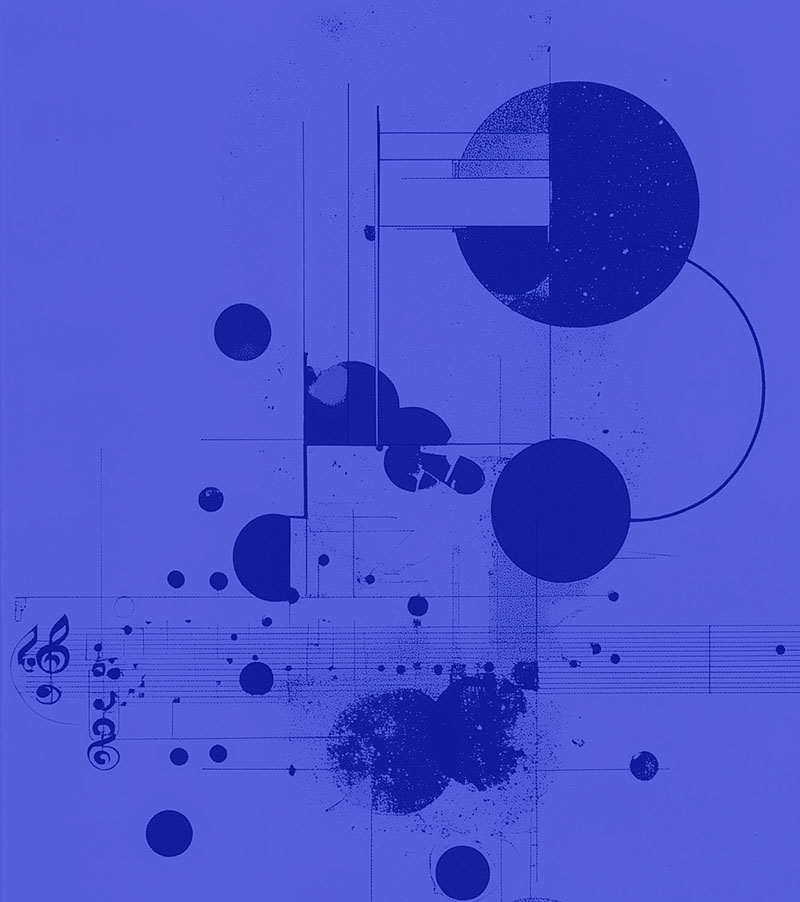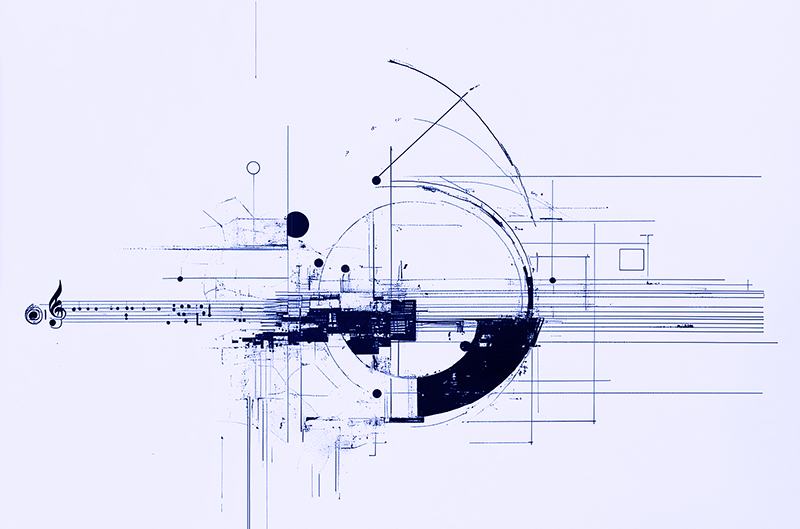
In July 2019 Modulisme was born, Bana Haffar and I contributing the very first 2 Sessions. It was very important that my first guest be a woman, and I’d so much like more Ladies to respond to my invitations, for Modulisme to offer more of a female presence… And fully document our Electronic Music community…
Over the years, I’ve heard it said that the platform offers so much information that the newcomer doesn’t know how to take it in, where to start, that there’s too much to read… A simple reply would be « take your time » because Modulisme wants to share information, give composers a voice and make sure they have the opportunity to be well presented. The fuller their message, the better off I am, so here it’s all about transmission, and of course it may take time to digest… For the better !!!
We are celebrating 5 years of activism and offering more than 1 000 exclusive works showcasing the importance of analog electronic music !
For this series I wanted to emphasize the alliance of acoustic and electronic with a collection of works showing that Modulisme isn’t dealing with Modular synthesis only and that what matters is the composition rather than the tools.
ACOUSTRONIQUE features music composed of sounds artificially created using the modular instrument, enriched with natural sounds (field recordings/voices) or acoustic material (instruments).
This is volume 2 which I chose to limit to 2 hours so as to keep it digest…
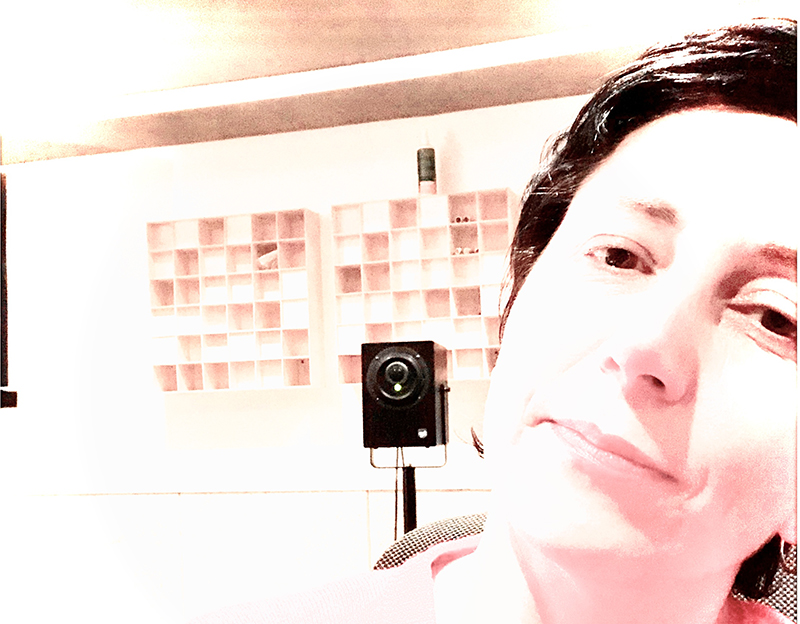
01. Ocean Viva Silver (Valérie Vivancos) – Indian Summer Fear Walking (04:10)
Improviser and composer of electroacoustic music, transdisciplinary artist Valérie Vivancos moved to Paris in 2002, after 11 years in the Anglo-Saxon underground. She has initiated sound creation projects and cross-disciplinary collaborations, works for cultural and humanitarian organisations, writes and translates literary and theoretical texts. She has led participatory actions from Brazil to Auvergne, invited the public to sleep in a bunker in Denmark, spatialised her music in a planetarium, on acousmoniums, performed on the Danube, played with sound objects in Hong Kong, danced with Fluxus choreographers, swum in open waters, created soundtracks for museums, binaural flows, poetic islands or surveillance cameras. She has released some albums, received commissions for art, music and radio pieces and frequently performs internationally.
This piece recalls the closing of cycles, composed at the very end of the summer of 2024 after a whole host of unsettling experiences, a blend of scenes… the Estonian forest on a peninsula in the Baltic Sea, the people of Catania walking through the streets with umbrellas, under a shower of black ash, stormy moments and shades of light.
I’ve integrated past recordings of modular synths recorded during residencies, Buchla at the EMS and Serge at the GRM, with the sounds of forest fires, crackling organic elements, melodic layers and ghostly voices. The idea was to conjure up an altered state of consciousness where failing memory mixes with dreams, where one goes through strong emotions as if through a landscape, a season….
I work in a concrete way, selecting the sounds that best convey my inner state. I then arrange and fine-tune them by ear, either through accumulation or subtraction, adding details to accentuate the relief.
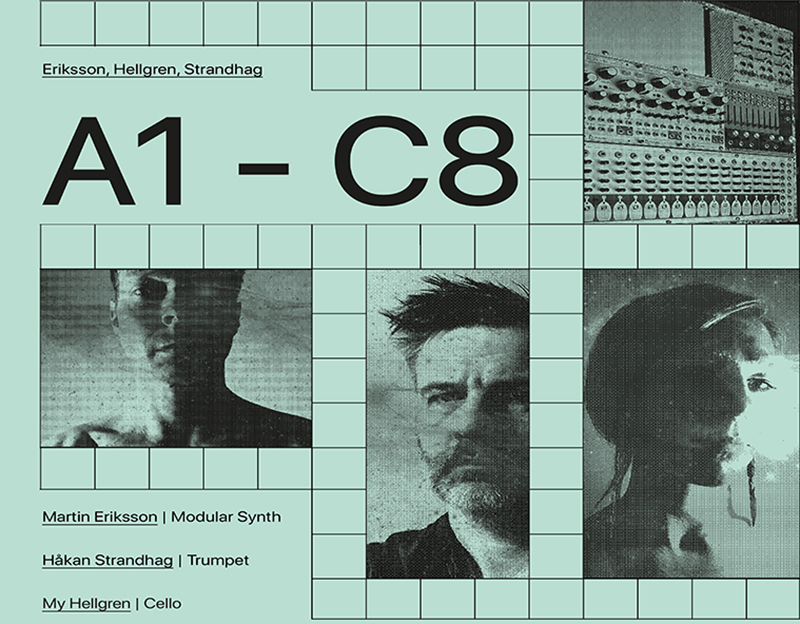
02. Eriksson / Hellgren / Strandhag – Elektronmusikstudion 2022 (04:43)
produced at Elektronmusikstudion in Stockholm, in 2022.
Martin Eriksson is an architect working in many different fields. He is also a composer connected to Elektron Musik Studio.
The main idea is to create music in dialogue. Starting with graphic notations that were made on the fly title pages of Peter Englunds novel Onda nätters drömmar on a long and rough bus journey from Stockholm to Berlin.
It is three pages A, B, C.
Each paper is divided inte 8 sections, hence A1-C8.a
These notations were transcribed by musicians My Hellgren, cello, and Håkan Strandhag, trumpet, who have collaborated with Martin Eriksson in earlier projects.
My is often seen in contemporary chamber music projects in Sweden + internationally.
Håkan and Martin have been making music together for a long time in the band Överklassen.
For more infos please visit:
https://modular-station.com/modulisme/session/99/
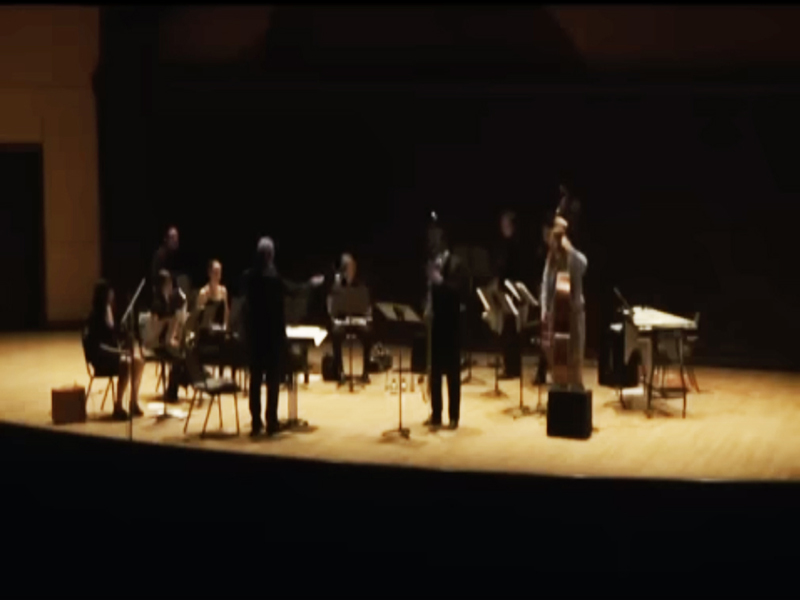
03. Daniel McKemie – Concerto for Contrabass Clarinet and Nine Musicians (10:07)
Soloist – Drew Ceccato
Conductor – Steed Cowart
Recorded live at Mills College; Oakland, CA May 2011 Mastered by Ryan Ross Smith
Daniel McKemie is a composer, percussionist, electronic musician, researcher, and arranger based in New York City.
His current work includes using techniques rooted in Music Information Retrieval to develop new sound palettes and approaches to audio processing. He also focuses on utilizing the internet and browser technology to realize a more accessible platform for multimedia art. His music has been performed in Europe, Asia, South America, and Australia; and his research on computer music and web-based audio/composition techniques has been presented and published internationally in conferences such as the Korean Electro-acoustic Music Society, the Australasian Computer Music Association, the International Symposium on Computer Music Multidisciplinary Research, the Society of Electro-acoustic Music in the United States (SEAMUS), and Percussive Arts Society International Convention (PASIC), among others.
Concerto for Contrabass Clarinet and Nine Musicians was the last piece I composed as a graduate student at Mills College. The aim was to combine techniques and ideas around blending improvisation and notated music within structures that have varying degrees of openness. While my studies with Roscoe Mitchell mostly centered on analyzing baroque music, classical forms, and thematic development, it was in our discussions regarding the approaches of composition and improvisation being interchangeable, where this piece was born and became its driving force. The ensemble instrumentation, [trumpet, alto saxophone, piano, percussion, 2 sopranos, violin, and two contrabasses], was chosen simply because of that being the makeup of the Contemporary Performance Ensemble that year.
There are two elements of electronics employed, the radios in the percussion section and amplification of the ensemble. Radio as a sound source was used in much of my electronic music at the time, tuning to noisy bands and finding “non-musical” artifacts, and that timbre palette was used to construct the ensemble parts. Simply put, a transcription of radio noise. Amplifying the group helped this further as the core sound quality of each instrument is subtly, yet certainly altered, and the result being something more ‘electronic’. This coupled with the radio broadcasts in the percussion section, provides layers of interaction in the space. While it seems contrary to not amplify the soloist, the reason was to allow Mr. Ceccato the ability to weave within the sound of the ensemble, to support and expand choice elements at different times, creating an improvisatory setting not centered on pitch and rhythm, but rather on timbre.

04. Vosh / Moore / Barbiero – Cell Modulation for trio (07:53)
Dave Vosh: analogue modular synthesizer.
Daniel Barbiero: double bass.
Ken Moore: crystal bowls, bronze singing bowls, Strymon NightSky reverb pedal, assemblage.
Dave Vosh has been exploring electronic music since the 70`s and draws his influences from the pioneers of the 50`s, 60`s and 70`s. He has performed widely in D.C., Maryland and Virginia as a solo artist and with artists such as Ken Moore, Chris Videll, John St. John, Bev Stanton and Art Harrison. His recordings are available on the Zeromoon, Pan y Rosas and Anvil Creations netlabels.
Ken Moore: Born in Baltimore, Ken began his interest in music at age 7 with piano lessons. He began recording toy instruments, started a rock band, and wrote music for organ until college. By 1980 he was selling his music on cassettes, then quit rock for electronic music, continuing experimental music by releasing albums on Bandcamp in 2010. In Audion #5 Alan Freeman said, “His tape manipulation and avant-garde electronic works seem to be his most known style. »
Daniel Barbiero has been active in improvised and experimental music and dance in the Baltimore-Washington area as a performer, composer and ensemble leader since the early 2000s. His music is inspired by the chromatic vocabulary, open-form compositional structures, and extended performance techniques of mid-20th century Modernism. His verbal, graphic, and other scores employing nonstandard notation have been realized by ensembles and solo artists in North America, Europe, and Asia.
“Cell Modulation” began life in connection with a projected duo collaboration between Dave and me. Dave and I have worked together for many years; we both enjoy the sonic catalyst to be had by combining his essentially abstract electronics with the organic sound of my acoustic instrument. In July 2023, Dave sent me some recordings he’d made of soundscapes auto-generated from his analogue modular synthesizer, a hybrid made up of Doepfer and other European modules. After some careful listening to Dave’s recordings I selected one whose phrasing and timbres I found congenial and in response to it recorded a structured improvisation based on the Bartok X, Y, and Z three-pitch cells and derived transpositions. (Hence the name “Cell Modulation.”) I matched my recording to an excerpt I’d chosen of one of Dave’s recordings, mixed them, and then put them aside. When Dave, Ken, and I began working on our trio collaboration I pulled the piece out of storage and sent it to Ken to see if he wanted to do something with it. Ken contributed a recording of six crystal bowls, and added a layer of his recording in reverse in various places.

05. Phlippe Petit – Eerio Under The Juniper Tree (05:25)
Sculpting sound like a craftsman, without restraint or sometimes “on the tip of the hands”, Petit is interested in the importance of the compositional gesture, to favor the live touch without repetitions, by impulse, in a very corporeal way.
“The Juniper Tree” – also The Almond Tree – is a German fairy tale published by the Brothers Grimm in 1812. The story contains themes of child abuse, murder, cannibalism and biblical symbolism and is one of the Brothers Grimm’s darker and more mature fairy tales…
« My mother, she killed me,
My father, he ate me,
My sister Marlene,
Gathered all my bones,
Tied them in a silken scarf,
Laid them beneath the juniper tree,
Tweet, tweet, what a beautiful bird am I.»Smoke, flames, and fire were rising from the place, and when that was over…
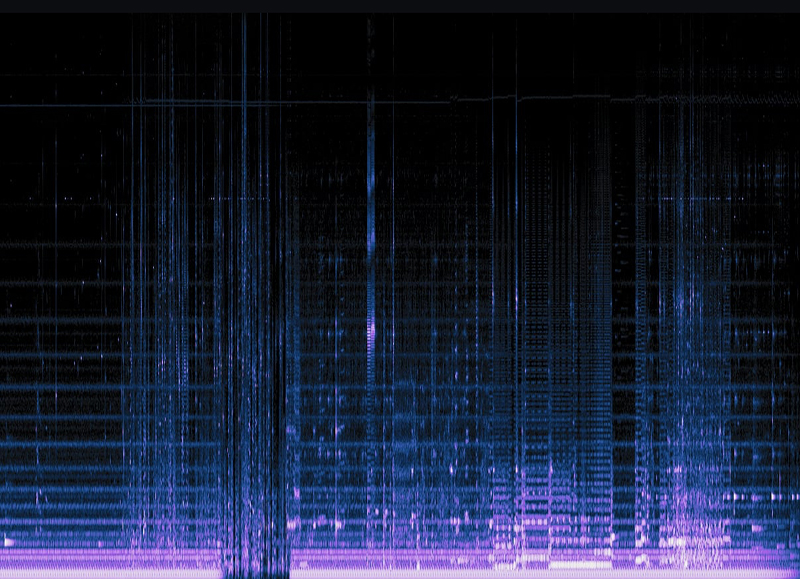
06. Jos Smolders – Late Night Groove (12:22)
The music of Jos Smolders is always on the border of abstraction and narration. An important influence in his artistic development was a confrontation with the early works of Willem De Kooning whose work in the 1950s was both abstract ánd concrete. With Smolders’ music concrete, everyday sounds meld into intricate and abstract layers of sound. Zooming in and out, exploring the techniques for crossing the borders the listener is drawn into the journey just as much as the composer. Sometimes it’s harsh though not for long because things are constantly evolving like a river of also constantly changing matter. The works sometimes can be experienced as landscapes are objects, at other times they are quite moving and the listener is carried away with the narrative of sound.
This piece was recorded in one session on March 24, 2021. The session started at 21:52 and lasted 22 minutes and 30 seconds.
Mainly I used the Hordijk system, but also Blippoo box and a Nebulae2 modular (for the sax sounds which were played by Guido Nijs a few weeks earlier).

07. Wilfried Thierry – Series Instables (05:31)
Sound and visual artist, Wilfried Thierry explores different musical approaches and composes for theater and cinema, creates art performances and installations.
I chose to use acoustic drums with my Buchla system. The drums are the instrument that led me to music by chance when I was a teenager. Even though there were periods in my life when this instrument was more or less present, I always came back to it whenever I could.
For the past two years, I’ve been exploring the possibility of recreating the harmonic and phase-shifting effects of acoustic percussion using the Buchla synthesizer (for instance in Percepts published in Buchlaisms 5). When Philippe Petit invited me to create a piece mixing acoustics and electronics, it seemed obvious to me to pursue this work on the acoustic properties of percussion, and the two pieces created on this occasion are two different explorations of the same subject.
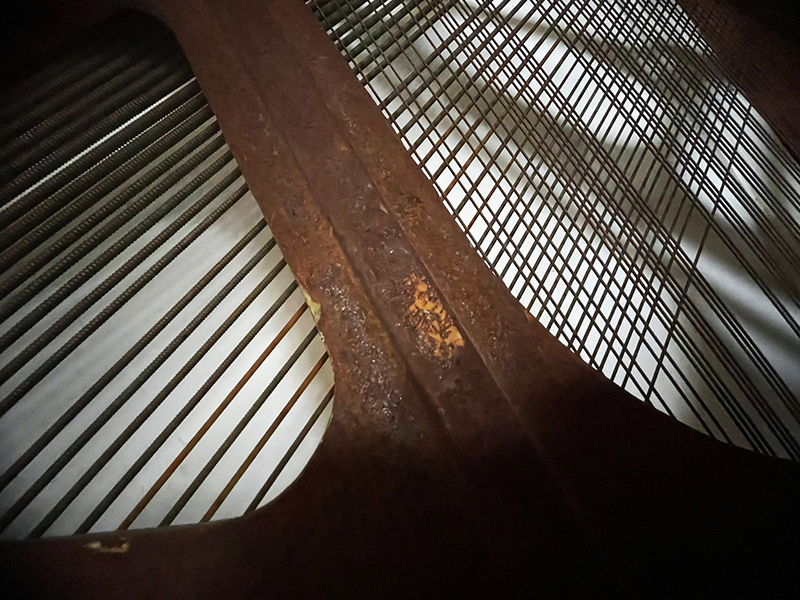
08. Sion Orgon – Bronze Age Prostitute (06:21)
Rubbed Cymbals, Treated Piano Frame, Lexicon PCM 80 Reverb, Electric Guitar loops, Modular System, Moog Voyager, Audiomulch, AM Radio
Sion Orgon, a versatile creative force hailing from Cardiff, Wales, is a renowned experimental musician, composer, singer, and songwriter with a professional background in avant-garde artistry. With a notable presence in the field of experimental electroacoustic music, sound design, audio mastering, and production, Sion’s influence extends across various musical realms. Boasting an impressive discography of six solo studio albums and a rich tapestry of collaborative works, Sion has worked along side with artists like Coil, Can’s Damo Suzuki, Alien Sex Fiend, Jesus Jones, William D Drake(Cardiacs), Alternative TV, Sleaford Mods, Hunting Lodge, The Waterboys, Splintered, Philippe Petit and the band Faust,
Alongside his musical endeavours, Sion’s adeptness in sound design has garnered acclaim in the realms of BBC Television/Radio, independent film, contemporary dance, theatre, animation and more, solidifying his status as a multifaceted artist.
A big aspect of creating electro-acoustic tracks for me lies in the method of recording solo takes without hearing the previous recordings. For me this approach adds an element of mystery and unpredictability to the creative process, as each solo take is influenced by my immediate surroundings, emotions, and inspirations. By recording solo takes in isolation, I immerse myself in the moment, allowing my musical ideas to unfold organically without external influence.
Recording solo takes without the constraints of predetermined structures or compositions also provides me with the freedom to explore new sonic possibilities and push my creative boundaries. While this method presents its challenges, such as maintaining coherence and consistency throughout the recordings, it also offers a sense of liberation and exploration that is essential for the development of my compositions.
Judicious editing plays a pivotal role in refining the raw material captured during the recording process and sculpting it into a polished and coherent composition. Through editing,I find I can highlight key moments, create dynamic contrasts, and weave together disparate elements to construct a harmonious sonic landscape….. « Orgonised chaos ».
I found myself sending synthesised sounds through 2 x Marshall amps and effects like a Lexicon PCm80 and Audiomulch’s granulation plugin. A method that added depth, saturation, movement and a different texture to the sounds.
Recording these amped sounds back into the computer using stereo microphone configuration in the room was the next step in the experimentation process. This technique not only preserved the nuances and subtleties of the processed sounds but also introduced a sense of authenticity and space to the track.
One of the central elements in the creation of an electro-acoustic track is the use of tools such as Mutable Instruments Clouds. By harnessing the granular freeze function of Clouds, AM Radio voices are transformed into ethereal textures that form the backbone of the composition. The modulation of these textures by a Buchla Model 281 Quad Function Generator adds depth and complexity to the sonic landscape, creating a sense of movement and evolution within the track.
I find creating Electro-acoustic music offers me a playground for experimentation with textures and timbres. The juxtaposition of familiar sounds, such as a crash cymbal, when mic’ed extremely close and played with soft beaters, yields unexpected results in the form of low, dark drones. Conversely, the exploration of rubbing the cymbal with a stick unveils haunting metallic high screams, adding a contrasting layer of intensity to the composition.
The Moog Voyager assumes a significant role in providing the foundation for the ambient looped guitars in this track. Through its ability to generate solid low drones, the Voyager anchors the composition, serving as a unifying force that complements the more volatile and transient elements introduced by other instruments and effects.
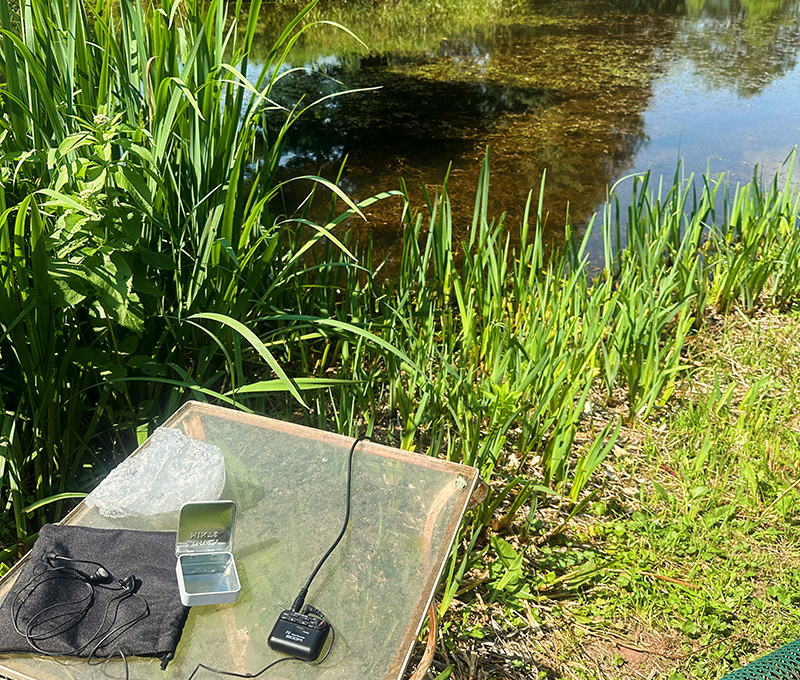
09. Hans Tammen – Filzschnee (04:30)
Hans Tammen is just another worker in rhythms, frequencies and intensities. He likes to set sounds in motion, and then sit back to watch the movements unfold. Using textures, timbre and dynamics as primary elements, his music is continuously shifting, with different layers floating into the foreground while others disappear. This flows like clockwork, “transforming a sequence of instrumental gestures into a wide territory of semi-hostile discontinuity; percussive, droning, intricately colorful, or simply blowing your socks off” (Touching Extremes).
I recorded the underwater sounds from a pond in Bloomville, NY with a Terranova Hydrophone, as you can hear there’s a lot going on under the surface. The last couple of months I was working with the Serge synthesizers at NYU’s Integrated Digital Media Program, so I tried to match the noises that I heard from under water, but not too close so that one still hears the acoustic and the electric.
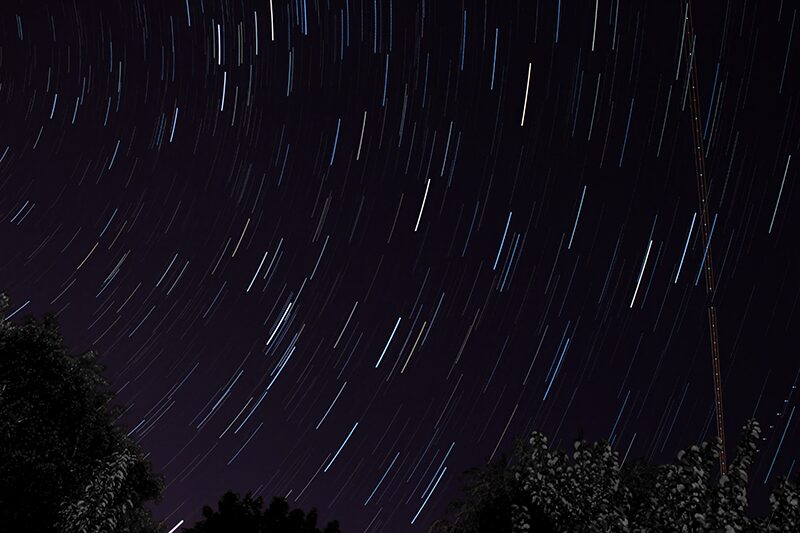
10. Not Your Average Worker Bees – Presence of Friction in Outer Space (20:10)
NYAWB improvise live electronic music using an array of modern and vintage synthesizers, acoustic instruments, and effects.
The duo consists of Paul Stillwell and David Sutherland who have been playing and performing together for about 10 years. When COVID came, they started using Telematics software in order to continue to practice every week. Improvisation brings a sense of joy and connection between us which we feel is a good enough reason on its own. If the music can bring some joy, relief from circumstances, or provoke thoughts in others, it becomes valuable for more than simply entertainment. It transcends into emotional connection, well-being, and, hopefully, inspiration. We hope that some listeners might find a connection to it and help their spirit take flight to another world/dimension/space that they can explore and appreciate.
« Presence of Friction in Outer Space » truly is a duet with Paul playing only Kaval and David playing only his EMS Synthi AKS processed by an Eventide H9..
Paul has been fascinated for years by the sound of traditional shepherd instruments from the Slavic regions of Europe, and recently acquired a Kaval. A member of the flute family of instruments. This particular instrument was made by hand from the trunk of a dogwood tree. Performing with the Kaval offers a degree of immediacy and subtlety of expression that is rewarding and difficult to achieve using a modular or keyboard synthesizer. For this performance we felt like playing something delicate with room for silence, and decided to challenge ourselves with strict limitations.
Paul’s practice is to use the Kavel as an input to an effects chain consisting of a mixer for the mic pre-amp directly into a SOMA COSMOS followed by a Source Audio Ventris reverb. The performance is achieved by playing the Kaval and adjusting the COSMOS and VENTRIS. The presence of the microphone allows for some flexibility in sources including vocalizations and percussion, in this case a rain stick.
The Bees’ music is more about the feeling of the sound, so harmony, dissonance, melody and rhythm are in service to the effect. An acoustic source such as an instrument or voice is simply another source that can be used to develop and grow a feeling. An acoustic source has its own properties, but at its core is no more different than an Easel or a MS-20.

11. Michael White & Dianne Aitken – Analogous (10:47)
Michael White is a composer, synthesist and performer. Moving to Toronto at 19 to study trumpet at the University of Toronto, he was exposed to a wealth of influences from orchestral to jazz to experimental concert music and rock. These experiences have continued to shape his career and interests. As a composer his love of electroacoustic music was born out of searching for new sounds and combinations to use as a film composer. For the past 20 years he has employed modular synthesizers, specifically the Serge Modular to for concert music and film composition. Michael’s electronic music can be heard on Modulisme and Modular Station as well as his Bandcamp site. His work on over 70 films and series is searchable in IMDB.
Based in Toronto, flutist Dianne Aitken has performed as soloist, chamber and session/orchestral player in Canada, Europe, China and the US. Dianne has been involved in a myriad of musical adventures. From solo and ensemble performances, to working with and performing under the baton of many of the world’s most notable contemporary conductors/composers such as Boulez, Carter, Sciarrino and Huber among many others. As longtime Flute Faculty at The Royal Conservatory and former Chair/Member, National Flute Association’s New Music Advisory, she continues to be recognized for her teaching, arranging/composing and curriculum development, including the development of the Overtones Flute Series and assistance in Hiroshi Koizumi’s Technique for Contemporary Flute Music (Schott ‘96).
“Analogous” is a duo for alto flute and serge modular. It explores some of the similarities of gesture and timbre the two instruments are capable of and their ability to complement each other. “Analogous” is intended to be played live in a flexible manner with multi channel diffusion. Rhythmic and melodic cells are presented in an improvisational framework giving the performers the opportunity to play off each other. At the beginning the extended techniques of the flute (key clicks, tongue ram, air, multi-phonics etc.) are set against more “noise based” sounds from the Serge. A melodic flute section follows which is harmonized by the Serge recycling the pitches of the melodic cells via an analog shift register fed by a tuned TKB sequence. As the piece progresses the melodic and noise elements merge to become a mixed and unified hybrid of the two approaches. The “melody” used in the piece is a very loose and slowed down version of a Robin’s song that we hear in our back yard late spring and early summer as it teaches it’s off-spring how to sing. The idea of imitation and acquisition of language is also an element that we improvised with. The piece was conceived, recorded and mixed in the summer of 2024 by Dianne Aitken alto flute and Michael White Serge modular.
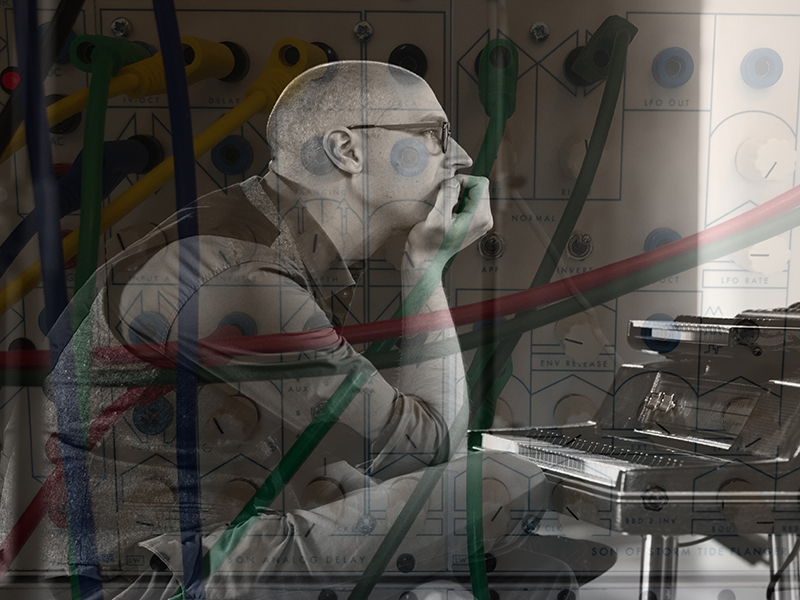
12. Raoul van Herpen – Photosynthesis (03:04)
Raoul Van Herpen is an electro-acoustic music composer and improvising musician from the Netherlands. In writing music he draws heavily on modern composition + improvisation techniques and loves to explore new “territories” and play with noise, electronics, textures, (Wurlitzer) piano, clarinet, saxophone + flutes and DIY Synhtesizers. Combining electronics, acoustics and silence…
I wanted to enhance and tread a pre-recorded improvised flute electronically and digitally.
It is not supposed to be “flute with effects”, instead being self operating and creating entities. The entities in this piece are the pre recorded flute. The flute enhanced and treated by the serge modular And finally the flute stretched and lowered in pitch digitally
I really enjoy using the Serge synth like this, it is such a big machine with so many possibilities, it’s almost difficult to choose what to do with it.
The Serge synthesizer is fed by the flute so it is only reacting and responding to the flute, enhancing and even adding its own sounds.
The digitally stretched/lowered flute sounds perfectly natural, a bit like a bass flute if you wil. Because it’s basically the same part as the “normal” flute part it sounds coherent like a conversation. It is actually a three-way conversation, three voices talking to each other with one voice as catalyst.
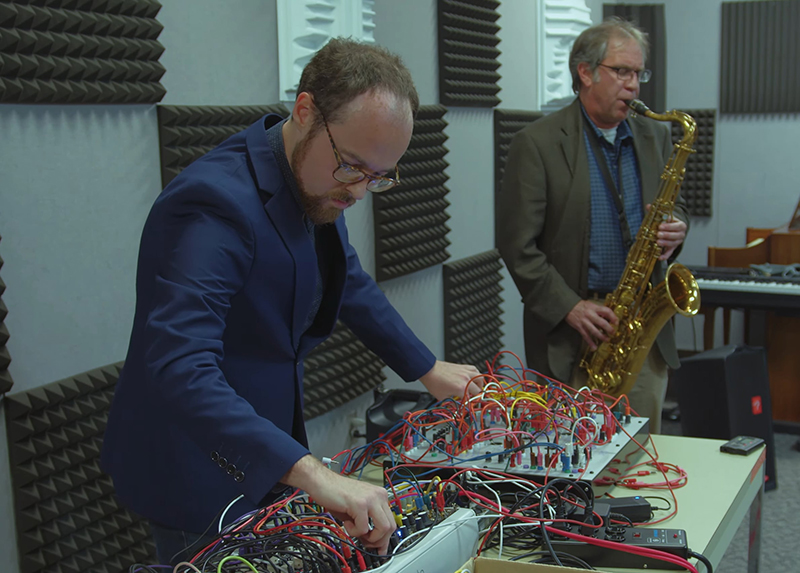
13. NOhio Electroacoustic Duo (Juan Dale & Joe Carucci) – Spatial Repercussions (04:54)
Juan Dale is composer/performer primarily on modular synths. After giving up classical guitar for modular synths, first learning on a small Eurorack system, he began restoring a 1980’s Serge 8-panel system and learning new instruments from Destiny+. Juan’s compositional work centers around the philosophical application of physics and mathematical concepts to a musical paradigm with the intent to open the mind’s ears by exploring new spatiotemporal relationships and the full sonic spectrum from sine waves to noise.
Saxophonist, composer, educator, and arts advocate, Joseph Carucci serves as Director of the Dana School of Music and University Theatre at Youngstown State University (YSU). Prior to his appointment at YSU, he served as the Director of the Eastern Kentucky University School of Music, and has taught at Lincoln Memorial University, the University of Minnesota-Morris, and Transylvania University as well as classroom and instrumental music in California, Kentucky, Massachusetts, and New York. He has performed and recorded throughout the United States, Canada, Japan, China and Colombia with artists such as the Temptations, Four Tops, Manhattan Transfer, Patti LaBelle, Christian McBride, and Eric Alexander. He played tenor and baritone saxophone with the DiMartino-Osland Jazz Orchestra and was an original member of Joslyn and Sweet Compression. Joe has led three studio recordings… Many of his compositions are available through Walrus Publishing, Jazz Lines Publications, and have been used on Pioneer Public Television for various programs.
This track is the result of free improvisation experiments between myself and Joe attempting to find common ground between a jazz saxophone lexicon and modular synths. The difficulty lies in avoiding an uncanny valley of bad jazz and uninspired electronic ramblings while embracing each instrument’s context. The result tends to borrow ideologically from beatmaking with its employ of familiar percussive elements, but with a mind towards expanding the space of rhythmic relations while avoiding the stochastic processes that deny listeners a sense of periodicity. Harmony and melody therefore suffer a demotion while texture and form are promoted a more prominent position in the hierarchy.
The instruments used are a tenor saxophone and modular systems from Destiny+ (Czochralski Cells and Entanglement Space) and John Nensen’s The Meta sequencer. The Meta is the sequencing brain which was patched as a makeshift Rungler circuit with LFOs from Czochralski Cells, sequencing the pitches of various voices and modulation destinations. I chose CCells to lean into the beatmaking aspect which is already embedded in jazz aesthetics, but in order to update the sound, I included Entanglement Space as an effects processor. Every “voice” or instrument present receives some kind of treatment from ES – experimental delays, flangers, modulated reverbs, etc. Some of these effects were recorded live in the session, others added afterwards in the mixing stage. These futuristic-sounding effects do a lot of work to congeal the disparate elements into a cohesive, dynamic, if spatially ambiguous mix where formulaic boundaries are dissolved and carried away in time.
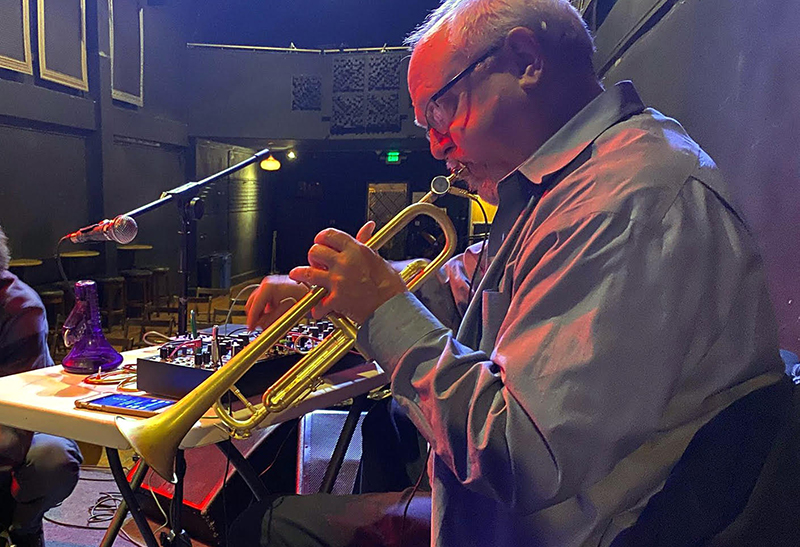
14. Tom Djll – Poetic Resonator Study (10:26)
Tom Djll studied electronic music with Stephen Scott at the Colorado College, working with the EMS Synthi 100. In 1978–79 Djll studied at the Creative Music Studio in Woodstock, NY, with Roscoe Mitchell, Anthony Braxton, Wadada Leo Smith, George Lewis, Karl Berger and others. He spent the years 1981-1993 working with the Serge Modular Music System (published work MUTOOTATOR, 1992); Deep Listening work with Pauline Oliveros, 1991. At the Mills College Contemporary Music Center Djll 1993-95, developed a personal trumpet language alongside electronic and microtonal studies. Further developments with his Bay Area band GROSSE ABFAHRT were undertaken from 1999 – 2016, released on the Emanem, Creative Sources, and Setola di Maiale labels. Beginning in 2012, Djll gradually re-introduced electronics into his sound-set, concentrating on analog systems and electroacoustic interfaces. Currently Djll concentrates on presenting and explaining chaotic sound-worlds, inspired by the work of Rob Hordijk. Recent collaborations with Gino Robair, Rova Saxophone Quartet, William Winant, Fred Frith and EUPHOTIC with Cheryl Leonard and Bryan Day.
When I put power into my instruments, whether that be breath or electricity, what begins happening in that moment informs my approach. The conditions are set, as in any greater or lesser chaotic system, as I begin to react to what I’m hearing, and altering parameters or adding notes and so forth.
There’s no goal in sight. The point is to fully actualize and realize every moment in its becoming.
Other approaches and resulting sound-worlds are employed in these pieces, reflecting succeeding moments in my life and different conditions obtaining inside and outside the studio at the time they were made. I don’t ask any more of the world. I don’t ask more of the listener other than to take in each piece on its own terms, as they each unfold in time.
“Poetic Resonator Study” leans heavily on both trumpet and Meng Xi’s Wing Pinger. Further resonant filtering is added by the BugBrand Crossover Filter at the beginning of the processor chain through which the trumpet signal passes. Much use is made of threshold levels where resonant peaks just begin to go in and out of self-oscillation, sometimes pushed over the threshold by the acoustic energy from the horn. In certain situations, this resonance is amplified by the harmonic I choose. The Wing Pinger is self-patched to fully partake of its chaotic behavior, and, at the same time, to radically distend the temporal gaps in its utterances (sort of a punctuated equilibrium dynamic), opening up space for the other sounds to sneak through. Finally, all this is put through the Lorre-Mill Comb Room to add yet more colors of fluctuating resonance and ambiance.
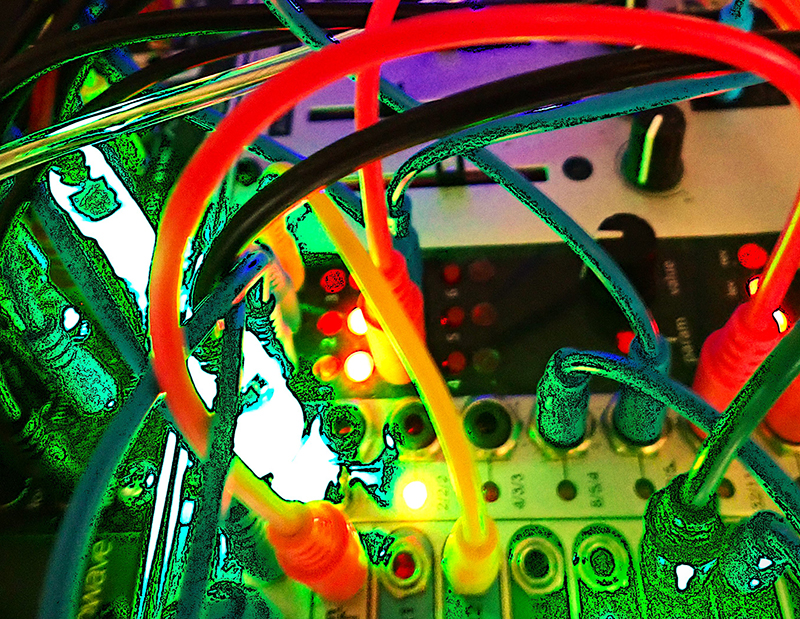
15. the ‘Brainwave’ project – Rosey (10:21)
Brainwave – Rosey Clements
Trumpet, Keys, Processing – Chris Dowding
The Brainwave instrument was developed for Musical Keys and directed by David Ross. The film was made by Oliver Payne
“Rosey” was recorded and mixed by Oliver Payne and David Ross.
‘Rosey’ is the first recorded evidence from the ‘Brainwave’ project, a collaboration with Norwich based charity Musical Keys, to develop a new instrument and means of musical expression for artists with profound and multiple learning disabilities.
We discovered the ‘Brainterface’ (from SoundMachines, Italy), -a system for gathering EEG data using a headset which works in combination with a synthesiser module to convert bio-signals into Eurorack compatible voltages.
Our ‘Brainwave’ effectively transforms a human brain into a generative CV source and provides a set of tools for controlling a modular system. It cannot transmit a musical thought or determine a specific musical outcome, rather the voltages generated reflect the state of a person. Broadly, the more energised the artist is, the more active the resulting control voltages seem to be. States of meditation, focus and repose seem to produce smoother, slower transitions and less drastic modulations. When the artist becomes focused on the sound they are making, a dialogue with the instrument begins..
The recording was made on April 26th 2024 at our third meeting with Lucy, Olivia, Lydia and Rosey. These four artists are engaged in ‘Sensory Studio’, a research and development project delivered by pioneers of multi-sensory theatre for PMLD audiences, Frozen Light.
The inclusion of a Make Noise Morphagene sampling module in the Brainwave made it possible to introduce acoustic sound into the control voltage environment. We invited trumpet/keys/electronics improvisor Chris Dowding to join us for the recording. I thought it would be interesting to sample Chris playing his trumpet prior to the session, curious to see if some kind of trumpet duet might manifest between the two musicians. There is a passage towards the end of ‘Rosey’ where this happens, to quite moving effect.
All our artists performed well that day but we have decided to present Rosey’s piece in its entirety. We have not edited anything as we want to show as clearly as possible the nature of the interaction between the two musicians and how the music develops between them.
